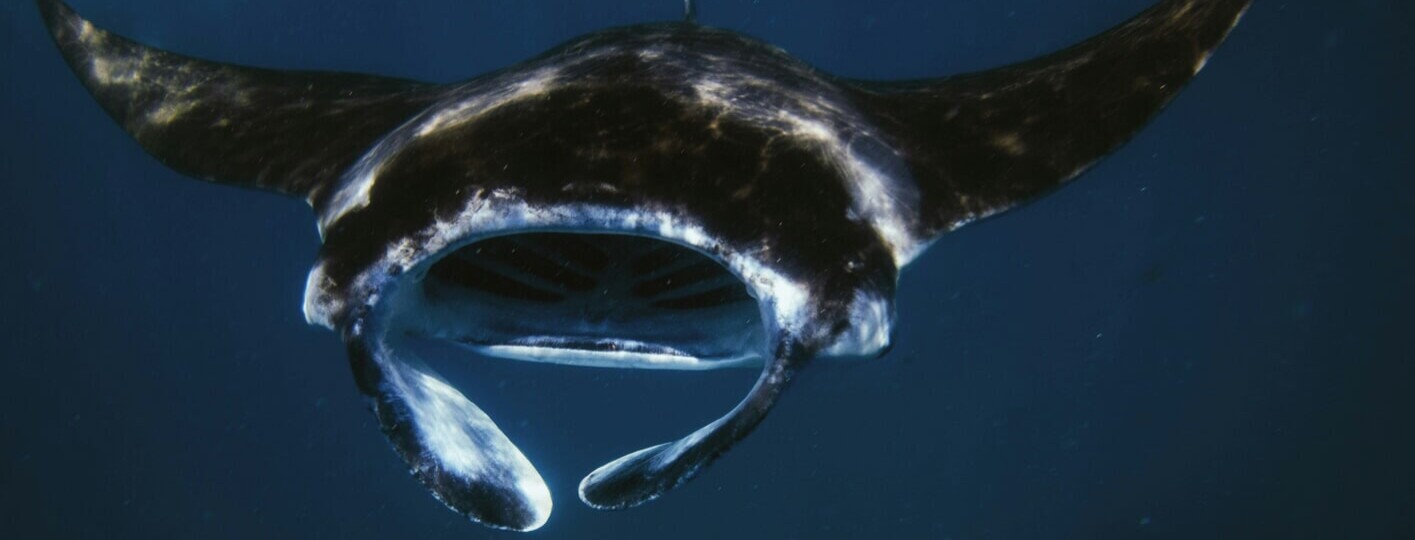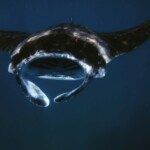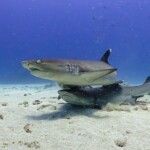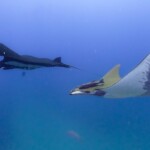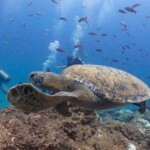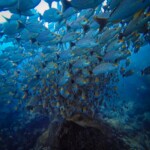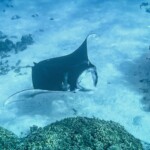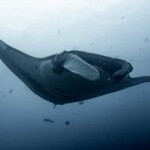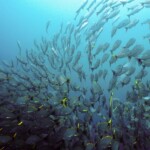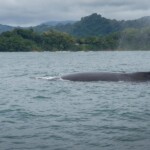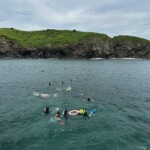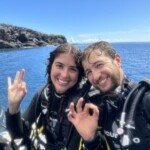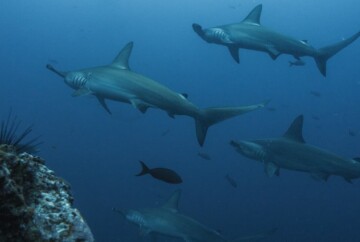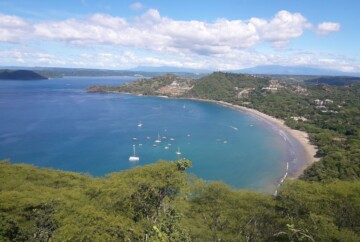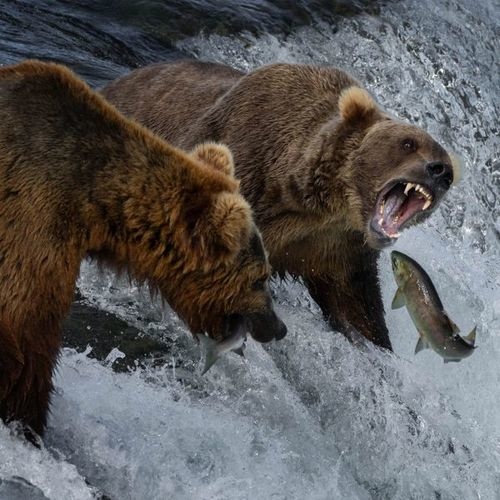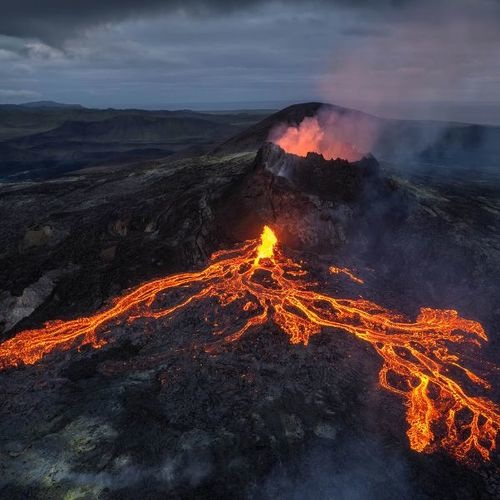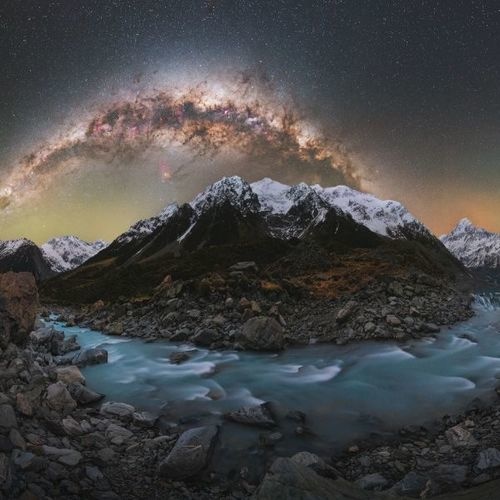When traveling abroad, get a policy from one of the best travel insurance companies. You can get a 5% discount on Heymondo, the only insurance that pays all medical bills upfront for you, HERE!
If you’re into underwater adventures, the Catalina Islands in Costa Rica should definitely be on your itinerary. This uninhabited archipelago doesn’t have beaches or tourist facilities, but its surrounding waters are a true marine paradise, filled with fascinating aquatic creatures and dramatic volcanic formations that make you feel like a real explorer.
Just a few miles from the coast, the islands are one of Costa Rica’s must-visit spots, especially if you want to swim alongside incredible giant Pacific manta rays, among many other marine wonders. It’s no surprise they’re considered one of the most spectacular diving destinations in Central America, with excellent visibility year-round and dive sites for all experience levels.
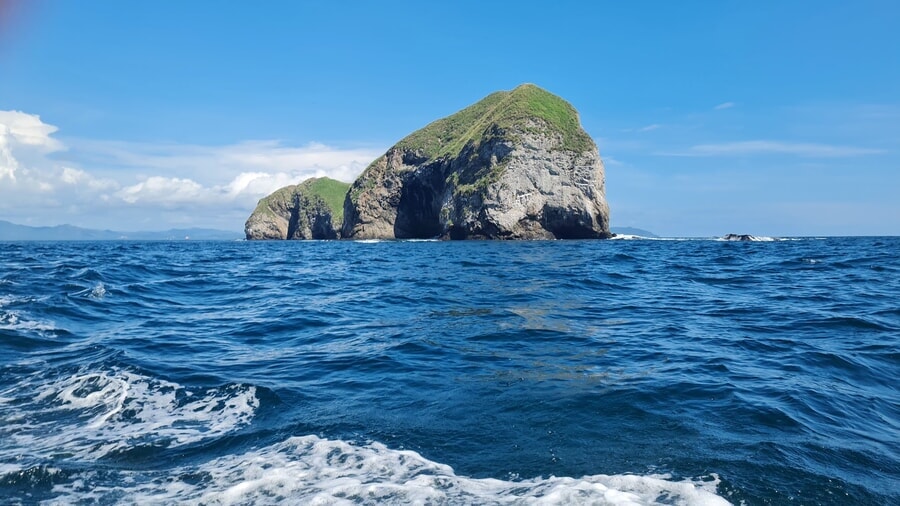
Guide to diving in the Catalina Islands, Costa Rica
This guide will give you practical tips, the best time to go, and everything you need to know to explore the Catalina Islands and uncover their underwater treasures.
Quick tip before you start: I highly recommend getting travel insurance for Costa Rica. We all hope never to use it, but medical care for foreigners here can be extremely expensive. And if you’re planning to dive, read the fine print. Most standard travel insurance policies won’t cover diving, so you may need extra coverage. Better to be safe than sorry!
Where are the Catalina Islands of Costa Rica?
The Catalina Islands are in Guanacaste province, right in front of Playa Flamingo, Playa Conchal, and Potrero. They’re also easy to reach from Playa del Coco and Playa Tamarindo, two of the most beautiful beaches in Costa Rica.
Thanks to their location, the islands are very accessible. You can reach the diving spots in about 40 minutes by boat from any of these places.
Best time to dive in the Catalina Islands
You can dive here all year round, but the best time depends on what you want to see and experience.
The dry season (December to April) is generally the best time to travel to Costa Rica. During these months, the water is cooler and the Papagayo winds bring stronger currents, which can make diving more challenging. The trade-off is spectacular: this is when large pelagic species arrive, especially the giant Pacific manta rays. From January to March, encounters peak and it’s not unusual to see dozens of mantas soaring overhead during a single dive. In general, these are the best months to see large pelagic species in the Catalina Islands.
The rainy season (also called the green season) runs from May to December and offers calmer seas and warmer water, making it a good option for less experienced divers. While visibility can vary, it often improves towards the end of the season (September to November). This time of year also brings fewer crowds and lower prices, making it a great option for those looking to travel on a budget.
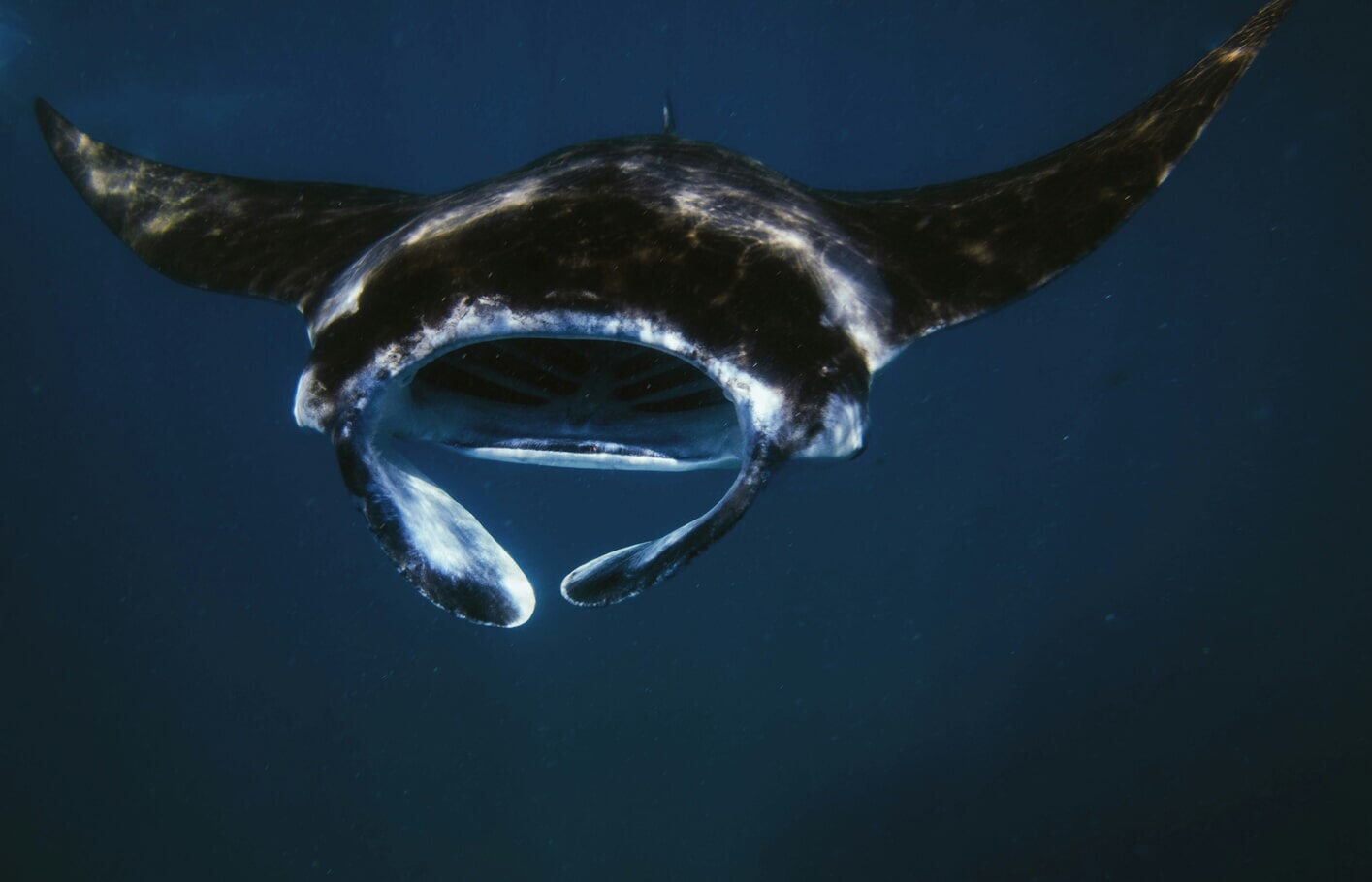
Best time to dive in the Catalina Islands
Another special reason to consider timing your visit: humpback whale migration. From February to March and again from July to October, these magnificent giants pass along Costa Rica’s Pacific coast. Not only can you often see them from the boat, but divers sometimes hear their haunting, melodic songs underwater. It’s such a magical, spine-tingling experience.
When we dove the Catalinas in January, visibility was excellent, and on our second dive we were lucky enough to see five manta rays. Our dive master mentioned that on other days the visibility can be even better. Honestly, we couldn’t have asked for more.
Requirements for diving in the Catalina Islands
To dive in Guanacaste, including the Catalina Islands, you’ll need at least an Open Water Diver certification. While many dive sites are accessible to certified beginners, some involve deeper dives and stronger currents. Because of this, many dive operators recommend having additional experience. Certain sites require a negative descent and a safety stop without a line—both of which can be a bit more technical.
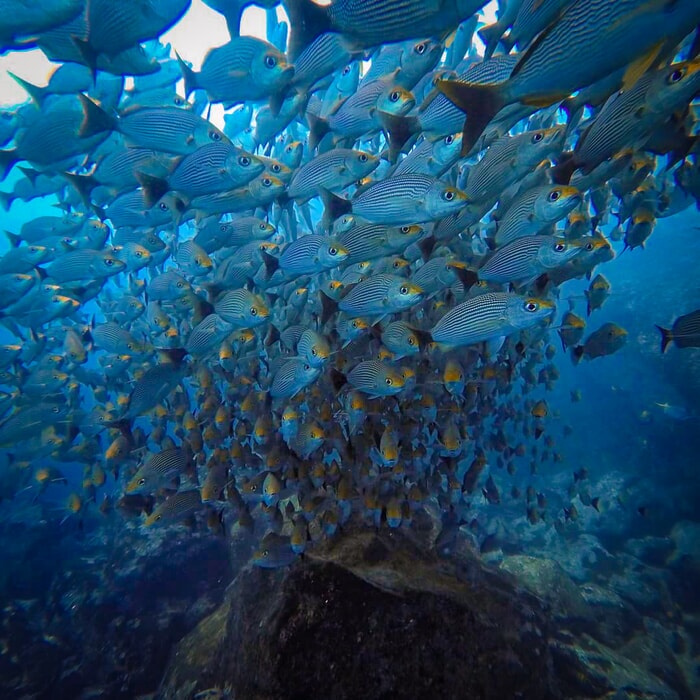
Requirements for diving in the Catalina Islands
If you’re not certified yet, don’t worry! You can still experience the Catalina Islands through a Discover Scuba Diving program. This allows you to dive under the close supervision of an instructor in more controlled environments. You’ll be limited to shallower depths (up to 40 feet), but even in these areas, the underwater scenery and marine life are stunning.
Best diving excursions in the Catalina Islands
There are several popular excursions in Costa Rica for divers, so you can choose the one that best fits your departure location, skill level, and how many dives you want to do. Most tours include boat transfers, diving equipment, and professional guides who know the waters and the best spots to see marine life.
And if you’re completely new to diving, you don’t have to miss out on the fun. Several operators offer introductory dives for beginners, so you can still get a taste of the Catalina Islands’ incredible underwater world—no certification required.
Catalina Islands diving tour from Tamarindo
Tamarindo is one of the most famous coastal towns on Costa Rica’s Pacific coast, and for good reason. It’s got a vibrant mix of restaurants for all tastes, accommodation for every budget, and a lively nightlife that keeps things fun long after sunset. There’s no shortage of tours in Tamarindo, but for anyone wanting to dive in the Catalina Islands, this excursion is the perfect choice.
If you’re already certified, you’ll enjoy two dives at carefully selected sites, with all equipment provided, plus snacks and refreshments along the way. The tour limits groups to just five divers, so the experience feels highly personalized and never rushed.
If you’ve never tried scuba diving before, you can join their Discover Diving program. You’ll start with a basic introduction and learn essential skills before taking two dives around the islands. It’s ideal for those unsure if diving is for them and want a safe, guided way to try it before committing to full certification.
Scuba diving excursion to the Catalina Islands from Playa Hermosa or Playa del Coco
If your base is one of the hotels in Playa Hermosa or Playa del Coco, you’re also in a prime position for a Catalina Islands adventure. Both are home to some of Guanacaste’s most beautiful beaches, and this excursion includes convenient hotel pickup in either location.
You can choose a morning or afternoon departure, making it easy to fit into your trip, as it only takes half a day. You’ll enjoy two dives at some of the best spots in the Catalinas, each offering unique marine life encounters. And for certified divers with an Advanced Open Water license, night dives are also available, giving you the chance to see the ocean come alive after dark.
Without question, this is one of the top things to do in Playa Hermosa.
Scuba Diving in the Catalina Islands from Playa Flamingo
If you’re in Playa Flamingo and already certified, this excursion is the go-to option for diving in the Catalina Islands, Costa Rica. You’ll join other certified divers and visit two of the area’s best sites, where manta rays, turtles, and tropical fish are regular guests.
For those without certification, the Discover Diving program here is a great alternative. It begins with a pool session to practice basic skills, followed by two dives in the ocean to depths of up to about 40 feet.
Get your PADI in Islas Catalinas, Costa Rica (from Tamarindo)
Years ago, before I was certified, I joined a Discover Scuba Diving program. The moment I surfaced, I knew I wanted more. While you can do as many introductory dives as you want without certification, they tend to cost more per dive than for certified divers, and your depth and freedom will always be limited.
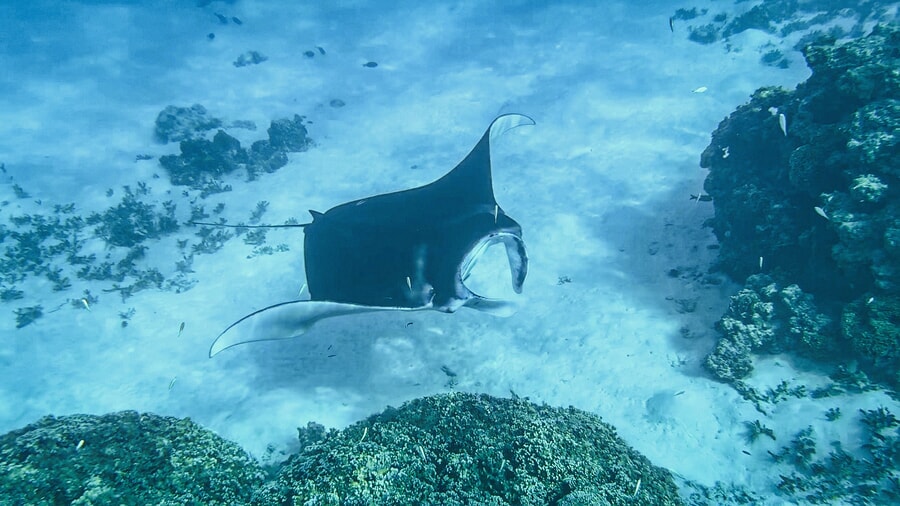
Get your PADI in Islas Catalinas, Costa Rica
Completing your certification means learning all the skills to dive with confidence, exploring at greater depths (up to about 60 feet), and getting far more out of every underwater adventure. It’s also a one-time investment that allows you to dive anywhere in the world.
If you don’t yet have a diving certification but plan to visit the Catalina Islands, you can take your Open Water Diver course in Tamarindo. By the time you finish, you’ll be ready to explore not only the Catalinas but any diving destination you dream of.
Best diving spots in the Catalina Islands, Costa Rica
The Islas Catalinas are dotted with numerous dive sites, but a few have earned a special reputation among divers. Here are some of the most popular and exciting areas:
El Clásico (The Classic)
El Clásico is the most famous dive site in the Santa Catalina Islands, Costa Rica. Its rocky underwater landscape and healthy coral reefs make it a magnet for marine life. Here, you can encounter giant manta rays, sea turtles, eagle rays, whitetip reef sharks, and large schools of jacks and trumpetfish. With a sharp eye, you might also spot moray eels, octopus, and lobsters hiding among the rocky pinnacles and crevices.
Currents can be present here, but they’re usually manageable.
- Maximum depth: 80–90 feet
- Difficulty: Medium
Las Pailas
Las Pailas is a site for more experienced divers, with deeper waters, stronger currents, and dramatic drop-offs. The dive is often done as a drift, meaning the current carries you along and the boat picks you up at a different location from the drop off. This requires good buoyancy control and the ability to descend quickly to stay with your group.
Underwater, you’ll find caves and crevices sheltering lobsters, moray eels, rays, and whitetip reef sharks. If you look closely, you may notice bubbling areas caused by mild volcanic activity (hence the name “Las Pailas,” which means “the cauldrons”). Common sightings here include giant manta rays, reef sharks, eagle rays, jacks, moray eels, and barracudas.
- Maximum depth: up to about 100 feet
- Difficulty: Medium to High
Punta Sur
Punta Sur (also known as South Point) is a striking dive site where deep rock formations are split by two channels, creating stronger currents than in many other areas. These currents attract schools of tropical fish, graceful sea turtles, and small reef sharks. One of the best things about diving here is that it’s less visited than some other Catalina sites, so you can enjoy a more peaceful, uncrowded underwater experience.
You’ll also find sloping walls and submerged pinnacles, which serve as natural shelters for a wide variety of marine species. Keep your eyes peeled for giant manta rays, eagle rays, sea turtles, and moray eels gliding or hiding in the rocky landscape.
- Maximum depth: 80–90 feet
- Difficulty: Medium to High
Los Sombreros (The Hats)
Los Sombreros gets its name from the rounded rock formations that poke out of the sea, resembling hats. It’s made up of two distinct dive sites, each with different characteristics.
The first, stretching from east to north, is shallow and perfect for spotting a wide variety of small fish. The second, from west to north, is deeper and more suitable for experienced divers. While it’s a bit more technical, it’s not overly challenging for those with the right skills.
Both sites offer varied seascapes and an impressive mix of marine life, including manta rays, eagle rays, moray eels, schools of tropical fish, and reef sharks.
- Maximum depth: up to 80 feet
- Difficulty: Easy to Medium
Cuatro Piedras (Four Rocks)
Cuatro Piedras is named after the dramatic rock formations that rise from a sandy seabed, creating a distinctive and photogenic underwater landscape. If you’re eager to see manta rays, moray eels, eagle rays, reef sharks, octopuses, and colorful schools of reef fish such as angelfish and butterflyfish, this is an excellent choice.
The rocks here are also covered in beautiful coral growth (both hard corals and soft sponges), along with vibrant algae. Currents can range from gentle to moderate, making the dive approachable for most divers.
- Maximum depth: up to 90 feet
- Difficulty: Easy to Medium
Elephant Rock
Elephant Rock is one of the most iconic and recognizable sites in the Catalina Islands. True to its name, it’s shaped like a giant elephant’s head rising from the water. Beneath the surface, you’ll find a spectacular world of volcanic rock formations, natural arches, and narrow channels that create a playground for adventurous divers.
This site is home to an impressive variety of marine species, but eagle rays, reef sharks, pufferfish, moray eels, lobsters, and giant manta rays are among its most memorable residents. Be aware that currents here can shift quickly, and some sections feature enclosed spaces that require good buoyancy control. For this reason, it’s best suited for advanced divers with some prior experience in similar conditions.
- Maximum depth: up to 80 feet
- Difficulty: Medium to High
What species can you see while diving in the Catalina Islands?
The waters around the Catalina Islands are teeming with some of the most remarkable animal species in Costa Rica:
Giant Pacific manta rays
Manta rays are the undisputed stars of the Catalina Islands. With their smooth, wing-like pectoral fins, manta rays glide through the water with incredible grace. Divers often travel here specifically for the chance to see them and for good reason. In the Catalinas, giant Pacific manta rays can grow up to 26 feet in length and weigh around 2.5 tons. Sharing the water with such a massive yet gentle animal is an experience you’ll never forget.
Despite their size, manta rays feed on tiny plankton, making them completely harmless to humans. Look closely and you might notice remoras (also known as suckerfish) hitching a ride on their bodies, taking advantage of leftovers from the manta ray’s meals.
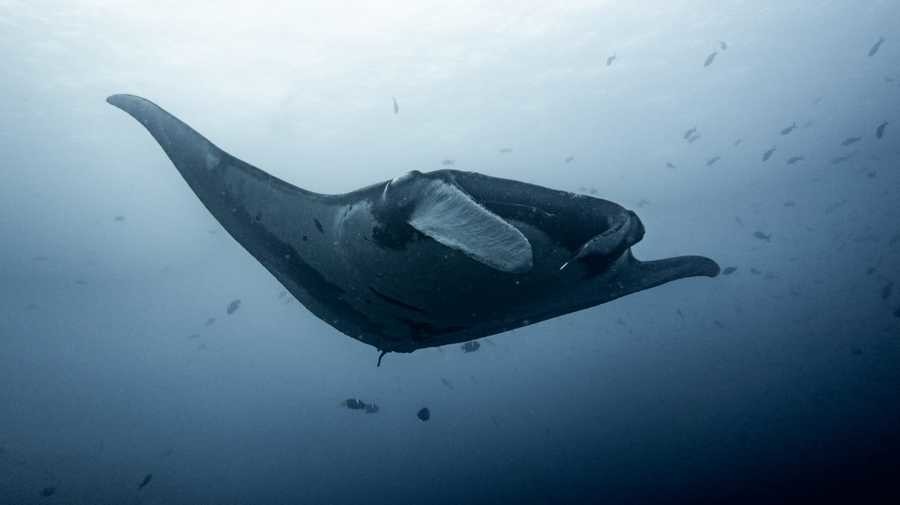
Giant Pacific manta rays
They’re often found at “cleaning stations” near coral reefs, where smaller fish remove parasites and dead skin. Many dive sites in the Catalina Islands are positioned near these spots for the best chance of encounters.
Important note: If you’re lucky enough to meet a manta ray during your dive, don’t touch or chase it. These animals are listed as endangered, with populations declining by about 70% in recent decades due to illegal fishing. By respecting their space, you help ensure future divers can enjoy seeing them in the wild.
Tropical fish
While the giant manta rays are a major attraction, the Catalina Islands are also bursting with smaller marine life that adds color and energy to every dive. Schools of tropical fish in every shade imaginable dart in and out of the reefs, which creates a magnificent underwater ballet.
Snappers are plentiful around near-shore coral reefs, moving in coordinated groups that shimmer in the sunlight. Angelfish add splashes of vivid color with their intricate patterns, while parrotfish (named for their beak-like mouths) graze on algae and seem to be wearing a permanent smile. The hogfish is another interesting resident; when stressed, it produces a distinctive grunting sound that divers often hear before they see it.
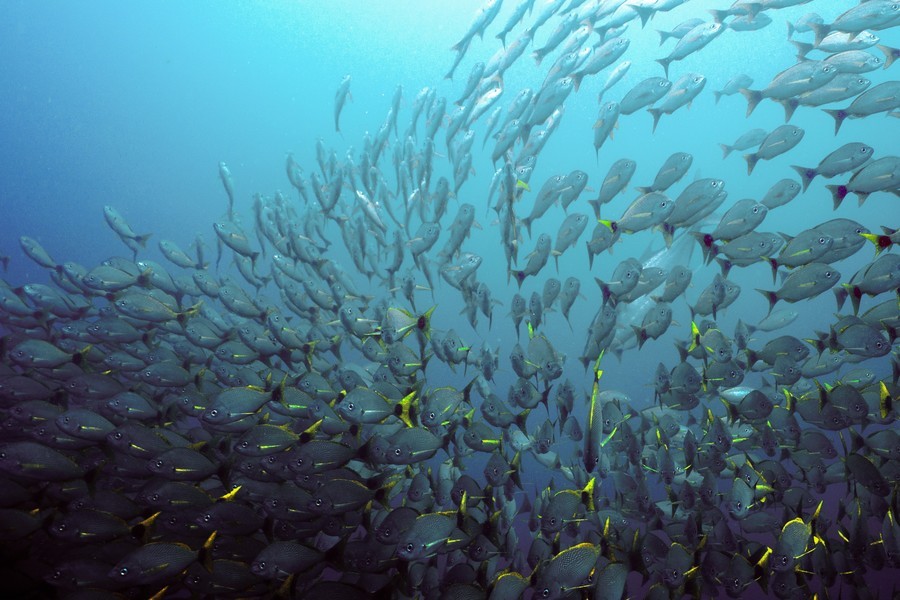
Tropical fish
The sergeant wrasse is easy to spot thanks to the five bold black stripes across its body, making it look as though it’s wearing a soldier’s uniform. Cleaner wrasse can be found performing their important job of removing parasites from larger fish, while the rainbow wrasse captivates with its shifting, iridescent colors. And then there’s the purple tang; an oval-shaped beauty with deep violet or blue coloring and a sharp defensive spine at the base of its tail.
Together, these tropical species bring the Catalina Islands’ reefs to life, ensuring that even if you don’t spot a manta ray or a shark, you’ll still enjoy an unforgettable, colorful dive.
Rays
Surprisingly, rays belong to the same family as sharks, sharing a cartilaginous skeleton, yet they stand out because of their flattened bodies and graceful, wing-like swimming motion that makes them seem as if they’re “flying” underwater.
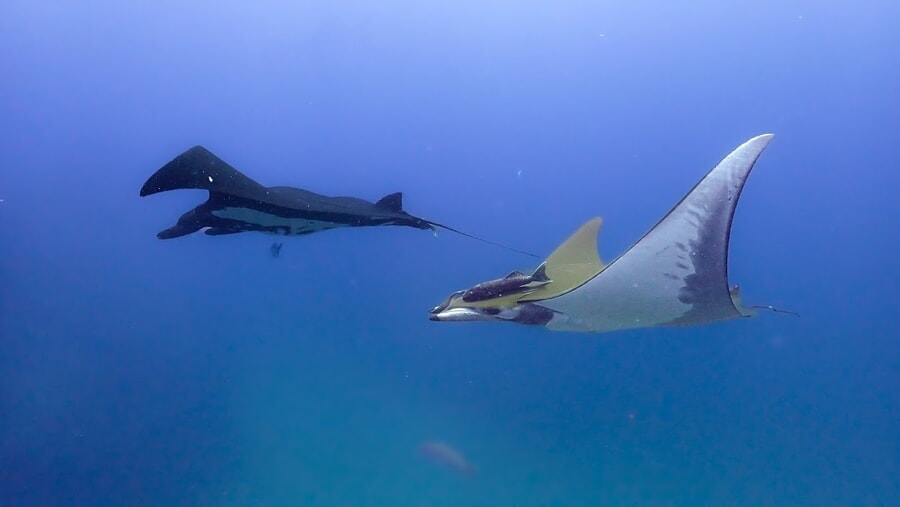
Rays
Among the most recognizable are eagle rays, with their sleek dark bodies adorned with white spots. They often glide elegantly through open water, sometimes in small groups, and their distinctive pattern makes them easy to spot even from a distance. Bat rays, on the other hand, tend to move slowly along sandy bottoms.
Then there are the devil rays, smaller than the giant manta rays, but just as captivating when they launch themselves out of the water in breathtaking leaps. Another frequent visitor to Catalina’s waters is the mobula ray, with its robust, almost diamond-shaped body.
Sea turtles
Sea turtles are my absolute favorite companions when exploring the Catalina Islands’ underwater world, and you’ll have a good chance of spotting them at many of the dive sites, especially the shallower ones. Depending on the season, you can even witness one of nature’s most magical events: turtle nesting and hatching along the coast.
Picture this: at night, a female turtle hauls herself onto the beach, digs a nest, and lays dozens of eggs in the sand. Then, months later, tiny hatchlings emerge and scurry toward the waves, beginning their life’s journey. If you’re interested in learning more, I recommend checking out our guide about turtles in Costa Rica.
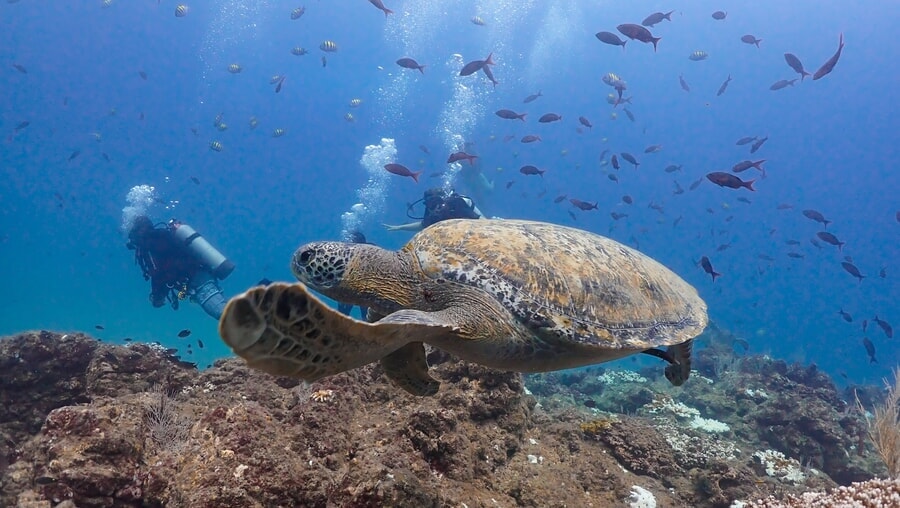
Sea turtles
This nesting season varies by species, but in general, the peak takes place between August and October. The most common turtle you’ll see here is the green turtle, with its brown shell and olive-green body. There’s also the hawksbill turtle, the rarest species in Costa Rica, easily recognized by its beautifully patterned scales. Sadly, they are still hunted and used for jewelry and crafts despite international protections.
And then there’s the charming Kemp’s ridley turtle, one of the smallest in the world, famous for its mass nesting events at Ostional Beach, where thousands of females come ashore at the same time.
Sharks
Sharks are among the most fascinating and mysterious creatures you can spot in the Catalina Islands. Most of the ones here are small reef sharks, completely harmless and often curious about divers. Personally, I have to admit that my most unforgettable shark encounters were on Cocos Island, where we swam among hundreds of them, including the iconic hammerhead sharks, but the Catalinas still have plenty of shark magic to offer.
Around these islands, you’ll most often see blacktip and whitetip reef sharks, easily identified by the distinct markings on their fins. They tend to cruise through shallow waters and weave between coral reefs, making them easy to spot. Sometimes they rest in rocky crevices or on sandy bottoms, so keep an eye out in those areas if you want a good look.
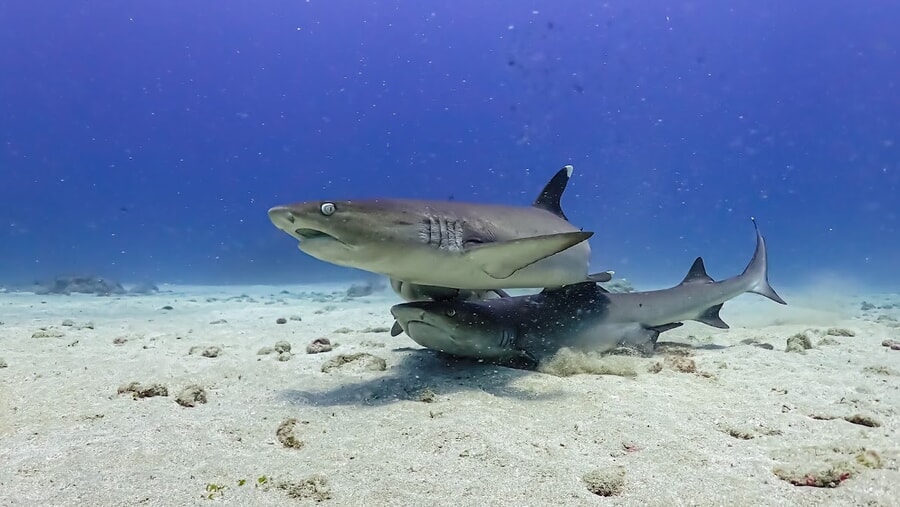
Sharks
If luck is really on your side, you might cross paths with a whale shark. While far less common than the reef species, these gentle giants do make occasional appearances here. At around 40 feet long, they’re the largest sharks in the world, but their diet is limited to plankton and small fish, so there’s nothing to fear.
And yes, there is one species worth a bit more caution: the bull shark, one of the most dangerous animals in Costa Rica. They can occasionally be spotted during feeding season in spring. Encounters are rare in the Catalina Islands, but if you do see one, follow your guide’s instructions and enjoy the moment. Seeing a bull shark here is truly a rare stroke of luck.
Humpback whales
Visiting the Catalina Islands during humpback whale migration season is an experience you’ll never forget. Sometimes you’ll see them breaching or slapping their fins on the boat ride out to your dive site, sending up giant splashes that sparkle in the sun. Other times, you might hear their deep, haunting songs while underwater. Either way, whale-watching in Costa Rica is an experience that stays with you long after the dive.
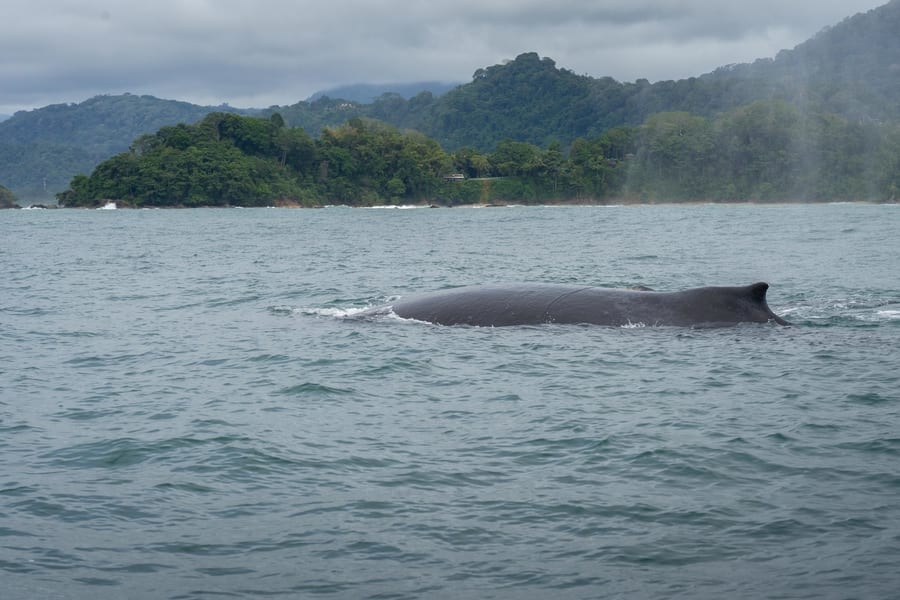
Humpback whales
Costa Rica is uniquely blessed with two whale migration seasons. From December to April, humpbacks from the Northern Hemisphere arrive, and from July to November, those from the Southern Hemisphere make their journey here. Around the Catalina Islands, humpback whales are the most common species, and they can reach impressive sizes, between 40 and 60 feet long and weighing up to 50 tons.
Snorkeling in the Catalina Islands
If scuba tanks aren’t really your thing, but you still want to explore the incredible marine life of the Islas Catalinas in Costa Rica, snorkeling is a fantastic alternative. Most snorkeling trips are boat tours departing from various points along Costa Rica’s Pacific coast, and they’re usually done in small groups so you can focus on enjoying the water without feeling crowded.
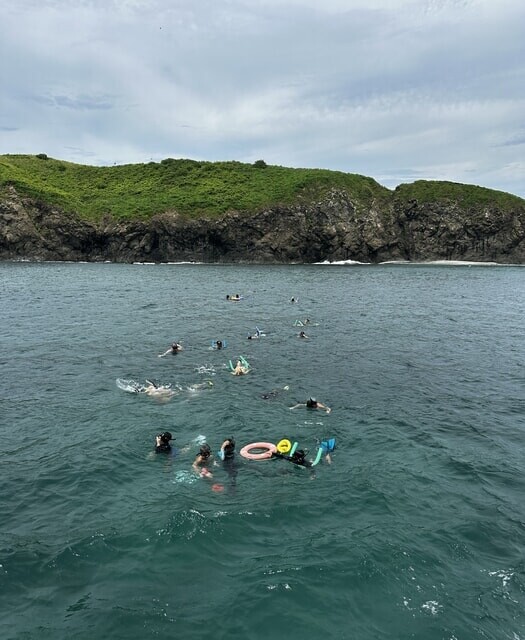
Snorkeling in the Catalina Islands
These trips typically include a captain and a knowledgeable guide who will help you spot and identify all sorts of creatures—from colorful tropical fish to reef sharks, rays, and even the occasional turtle—all visible right from the surface.
If you’re looking for great options, I recommend checking out this tour from Playa Flamingo or this excursion from Playa Tamarindo. While I haven’t personally tried these exact ones, they’ve earned plenty of glowing reviews from fellow travelers. So even if scuba diving isn’t your style, the Catalina Islands is still a perfect place to experience snorkeling in Costa Rica.
My experience diving in the Catalina Islands in Costa Rica
Diving in the Catalina Islands was easily one of the highlights of my entire trip to Costa Rica. We left Playas del Coco early in the morning, around 7:00 a.m., and set off on our adventure by boat toward the first dive site.
The ride took about 40 minutes, giving us plenty of time to check our gear, sip on a much-needed coffee, and enjoy the sight of the endless Pacific Ocean stretching out in front of us. The excitement of getting back into the water was already building.
We had booked two dives for the day, which made for a perfect half-day adventure. The plan was to spend the morning underwater and then relax on the beach in the afternoon, letting the adrenaline slowly fade while basking in the sun.
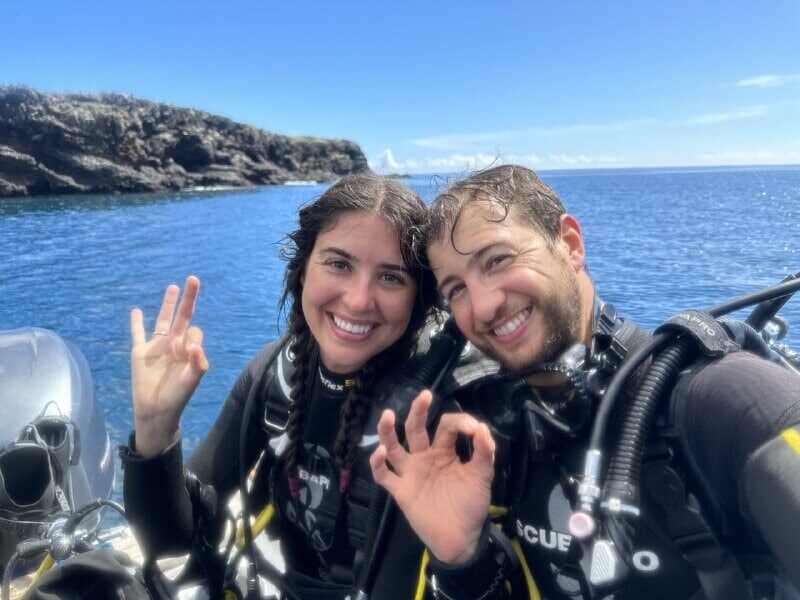
My experience diving in the Catalina Islands in Costa Rica
Our first dive took us to El Clásico, a lively spot teeming with life. We spotted graceful eagle rays gliding past, curious pufferfish, sleek moray eels, and massive schools of sharks moving together as though we were part of their world. Visibility was fantastic; exactly what you’d hope for in January, and the water was warm enough that a 2.5 mm wetsuit felt just right.
But the real magic happened on our second dive at Cuatro Piedras. As we navigated through narrow, picturesque rock passages, I noticed a manta ray in the distance. We paused to watch, and to our delight, it slowly glided toward us, moving with effortless grace. This one was huge—easily around 16 feet across—and I was completely mesmerized. Just as I turned to take it all in, two more manta rays appeared from nowhere. It made the moment feel almost cinematic. And as if that weren’t enough, while doing our safety stop at the end of the dive, we spotted two more in the distance. It was absolutely unforgettable.
While the manta rays were the highlight, the dives were full of vibrant marine life, unique rock formations, and colorful, thriving coral reefs. If you’re considering diving in Costa Rica, I can’t recommend the Catalina Islands enough. You won’t be disappointed.
And that’s a wrap on everything you need to know about Costa Rica’s Catalina Islands! I hope this guide inspires you to take the plunge into their incredible waters and discover their underwater treasures for yourself. If you have any questions or if you’d like to share your own Catalina Islands experience, drop a comment below. I’d love to hear from you.
Pura Vida!
